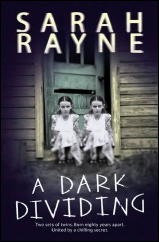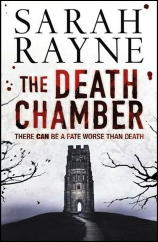August 2010
Monthly Archive
Tue 31 Aug 2010
Posted by Steve under
Reviews[5] Comments
A REVIEW BY CURT J. EVANS:
CAROLYN WELLS – Murder in the Casino. J. B. Lippincott, hardcover, 1941.
After reading The Gold Bag (1911, reviewed here ) and Feathers Left Around (1923, reviewed here ) — early and middle period Wells efforts respectively–I thought I would try a late one, Murder in the Casino. A casino setting might be interesting, I thought.
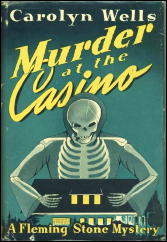
That was back in September 2009. Nearly a year later, I have finally forced myself to finish the book. Verily, dear readers, I hope the suffering I went through on your behalf with this one is appreciated.
What is Murder at the Casino about, you must be eagerly wondering. Well, one thing it is not about is a gambling casino (that might have threatened the merest modicum of excitement).
There is a murder at a sort of public entertainment hall for dances and this sort of building can be called a casino, but, for all the use Wells makes of the setting, the murder might have taken place at the opera, the bridge party, the flower show, et cetera — you would just have to take her word for it. This is probably the blandest mystery novel I have ever read.
To the extent this book is about anything, it is about lovely Rennie Loring. Or more exactly, Rennie’s eyes, to which Wells devotes the first chapter ( “Rennie’s Eyes”), as well as the last sentence of the tedious tale.
The author wants her readers to understand that the merest look from the intoxicating Rennie can conquer all men in her path. In short, Rennie is one of those tiresome Carolyn Wellsian child-women, ingenuously advanced in the art of coquetry but otherwise an absolute nitwit.
Wells had been perpetrating such characters since before World War One, but apparently her audience had an endless appetite for them, even on the eve of Pearl Harbor and the advent of Rosie the Riveter. So I suppose whether you like Murder at the Casino will depend a great deal on how much you like reading about idiot savant coquettes.
Renny’s brother and sister-in-law help get her married off to Nicholas Talbot, the richest man in the very rich suburban Connecticut community in which they live with Renny. Charming Renny throws over her old boyfriend to marry Mr. Moneybags. Unfortunately, Talbot proves to be a jealous tyrant.
As Wells interestingly puts it, Talbot had “a latent Othello complex, which it were wise not to monkey with.”
The couple take their honeymoon in Mexico City (though it could have been in their own backyard, for all the writing conveys of the atmosphere), and an inspired Renny, once back home, decides she wants to put on a Mexican dance at the local casino:
“Shall we have real Mexican girls and young men, or our own crowd, fixed up?” asks Renny. “Our own people, of course,” her husband declares. “We don’t want those brown folks around!” So the fun goes ahead, sans authentic “brown folks,” and with Renny dancing the lead female part and Talbot’s nephew the lead male part.
Describing this dance affair, Wells takes time, as was her wont, for a little fashion show commentary:
Renny’s costume … was a full red skirt with a green yoke, spangled all over, with a white silk low-cut blouse embroidered with beads of all colors … Steve Trask as the charro, was gorgeous in long, tight leather trousers, covered with silver buttons and chains, a soft leather jacket, braided in silver and gold, and a gorgeous serape.
If this were Agatha Christie, there would be something sinister about that serape, but, unfortunately this is Wells, and she is much more interested in pure fashion than murder, so what you see is all you get. Though a murder finally does take place, during the dance, when Rennie’s husband –surprise! — is stabbed to death.
For the rest of the book the wealthy locals emphasize that the foul deed must be the work of the radicalized lower classes (Emma Lazarus, what hath though wrought?!):
“Must have been…some disgruntled Communist who resented Nick’s wealth.”
“I suppose it must have been some of those bad men who hate rich people. You know what I mean, Reds, they call them, I think.” (Yes, this is Rennie.)
“You think, then, Rudd, that it was some laborer or workman?”
“I think the wicked man who who killed Steve was the same sort of man that killed my husband. Those bad people who make strikes and things.” (Yup, Rennie again, this time after a second dastardly murder.)
It would be pleasant to believe this is intended as social satire, but as Wells gives every indication that she greatly admires the stupid people of this wealthy suburban Connecticut town ( “a restricted residential district”), I think she is serious. You would honestly think it was 1886 and that the Haymarket Riot had just occurred.
Much of the dialogue in this tale (and the tale is mostly dialogue) is written as if the author’s first language were not English:
â— “Then I’ll give my advice to you… Put a little more dignity into your own performance, and curb your tendency to amorous gestures and tones. They are uncalled for and they greatly mar the picture.”
â— “It is hard to be sure, but I think Mr. Talbot believed the beneficent inscription, and that later, only yesterday, in fact, he learned the true translation, and that being attacked, he tried to get the ring off, and did so, but it was too late, and he dropped the ring under him, where it was later found by the detectives.”
â— “Yet the conditions are simple. Renny Loring and I have been in love for years. Along comes Talbot, and gets her away from me by reason of his great wealth and position and general attractive qualities.”
â— “I am an astronomer, Inspector, and on occasion I view the Heavens to see what the planets are up to now. The great windows in these halls offer fine views to a student of astronomy, and I enjoy them greatly.”
Wells’ greatest Great Detective, Fleming Stone, shows up and solves the case, though no discernible process of ratiocination that I could detect. Rather, Stone simply announces he knows who the killer is and the killer promptly confesses and kills him/herself with yet another one of those convenient poison pellets one finds so much in Golden Age tales, particularly those penned by Carolyn Wells.
Talk about dumb! This person must have been even dumber than Renny.
The entrancing and filthy rich Renny, by the way, does not the know the meaning of “berserk” or “privileged communications” and says “electricated” when she means “electrocuted.” Surely this helps explain why there is no chapter in Murder at the Casino entitled “Rennie’s Brain.” It would have had to have been a very short chapter indeed.
Murder at the Casino was apparently Wells’ seventy-ninth mystery tale (I cannot bring myself to call them detective novels). Two more Wells mysteries would be published after Casino in 1942 (one I believe posthumously).
My copy of Casino, published by Lippincott, a major publisher, is a very attractive volume: well-bound, good creamy paper, an excellent dust jacket. Lippincott must have known what it was doing publishing these later Wells books, but I cannot fathom why people enjoyed reading them. My only guess is that they were 1941’s version of “cozies,” but that guess it sort of insulting to many modern day cozy writers.
Perhaps the best comparison might be with the books Lilian Jackson Braun was writing in her nineties, before her publisher, Putnam, finally dropped the series in 2007. However classically “alternative” (to borrow a term from Bill Pronzini’s Gun in Cheek) Wells’ earlier mysteries may be, they cannot match Murder at the Casino for sheer inept daftness.
Tue 31 Aug 2010
REVIEWED BY WALTER ALBERT:
A Tribute to Fred.
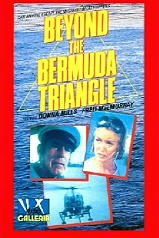
BEYOND THE BERMUDA TRIANGLE. Made for TV movie: NBC, 6 November 1975. Fred MacMurray, Sam Groom, Donna Mills, Suzanne Reed, Dana Plato, Dan White. Director: William A. Graham.
One of my life-long weaknesses has been the indolent habit of napping in the afternoon. However, I have always observed that I don’t have any interesting dreams when I nap, and I have concluded that I might put the time to better use by propping my eyes open and reading a book or watching a film that I might, in my more alert moments, not want to waste my time on.
I would like to think that this might occasionally lead to one of those “fortuitous” encounters in which the Surrealists believed and where marvelous consequences sometimes follow upon the most banal circumstance.
For those of you who would like to delve more deeply into Surrealist philosophy on this point, I refer you to Andre Breton’s Nadja, especially those pages describing his addiction to the American chapter play, Trail of the Octopus.
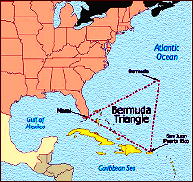
I was, earlier today, at a point where waking and sleep are no longer contrary conditions when my somnolent fingers brought into view on the TV screen, the opening scenes of a WTBS Sunday afternoon movie, Beyond the Bermuda Triangle.
I have always been intrigued by psychic phenomena, ever since those years when I used to look for the door to the Land of Oz in the closets of my grandparents’ farm.
Even in my bemused state, I quickly gathered in the essentials necessary to follow the storyline, which involved the disappearance of a boat in the area of the Triangle, and a young girl’s belief that her mother was still alive, somewhere “out there,” and was calling to her.

I had some trouble with character relationships, but deduced that Sam Groom is courting the sister of the missing woman who is taking care of her young niece, while Fred McMurray (with either a hair-piece or his hair dyed a sinister black) is probably the grandfather of the bereaved child, but is somewhat distracted by his pursuit of a much younger woman who is, herself, to disappear into that same hungry triangular area where the compass goes batty but where there is always time to send one last radio message before static claims the airways. Whew!
There is also a character to whom I felt peculiarly drawn, a retired professor who, years earlier, had lost his wife in the triangle and, at the last moment, close to the opening of the door to the “other side,” hesitated and was forever barred from crossing over.
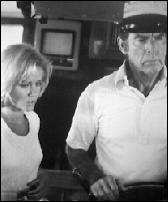
That had obviously bothered him no end, and, in a touching and significant scene, he tells MacMurray that there is one thing bigger than this life “down here” and that’s “love.”
That choked me up a bit and fogged my glasses, and when I could see clearly again Fred was casting off to sea with Groom’s girlfriend.
That lead to a really tense climax in which Groom, pursued by the Coast Guard, raced to intercept Fred’s boat. I don’t want to give away the ending (which would be foreign to the spirit of this blog), but let me tell you that the Old Professor was right on target, and some old geezers are quick studies.
This made-for-TV movie had everything: a grieving child in peril, weird music, mysteries beyond our mortal ken, references to Atlantis, and an impressive, late-career performance by Fred MacMurray.
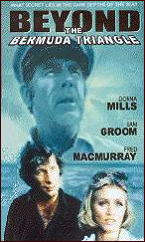
Now, I know that some people think Fred wasn’t much of an actor and got by on an earnest look and a commanding, sonorous voice. Well, here it was all in the eyes: the body was slack, the demeanour reserved, but the eyes seemed to reflect glimpses of something that sent a shiver down my spine (or rather up, since I started sliding out of my seat at one point and almost jackknifed on the floor between the chair and footstool).
I wish they had given the movie a less obvious title, something like Empty Boats. Still, since this might be a picture that only a recent retiree can appreciate, if you ever get a chance to watch it and don’t agree with me, don’t call me, I’ll call you.
But while you’re waiting for my call, don’t go into your closet. You never know who … or what … might be coming into it from … out THERE!
Mon 30 Aug 2010
Posted by Steve under
Reviews[2] Comments
JACK HIGGINS – The Killing Ground. G. P. Putnam’s Sons, hardcover, January 2008. Berkley, deluxe paperback, November 2008.
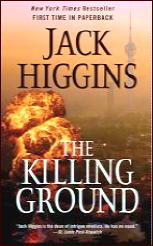
Jack Higgins was born in 1929, which means he was 79 when this book was published in the US – and unfortunately, it reads like it. The basic story telling ability is still there, but this particular episode in the continuing adventures of Sean Dillon, former IRA operative, and Billy Salter, former East Ender gangster, now both working for British Intelligence, reads like a first or second draft, no more than semi-polished.
There are no typos, but Higgins’ bare bones style, including the dialogue, is even more bare than usual, and except for the primary villain, there is no depth to any of the characters, none at all.
The dialogue is curiously cliched and flat, and worse, with bad paragraphing and often no clues, there are times when it is impossible to know who is talking. People who are in a room in one scene somehow seem to disappear, only to be found mysteriously somewhere else one or two paragraphs later.
Kidnapped is the young daughter of a well-to-do Iraqi couple, taken back to that country and her grandfather while the disastrous aftermath of the Iragi War is still going on, her hand promised in marriage to a cousin who not so incidentally is a notorious terrorist generally known as the Hammer of God.
There are some subplots here and there, but none of any consequence. The action goes back and forth, but the good guys are just plain too good at their job, and the bad guys are totally inept. Too bad the real world doesn’t work that way. (One does get tired very quickly of every bad guy being shot squarely between the eyes, at least ten of then, every single one of them, but perhaps I lost track after a while.)
Some complications do arise, mostly foolish stuff such as the girl’s mother, a noted surgeon, using a cell phone to contact her hospital while she and her family are supposed to be in hiding. And of course the opposition is listening in, for all of the good it does them.
One would like to think that the grand finale would be worth wading through this morass of unenergetic plotting, 415 pages worth, but one would be wrong, alas. The bad guys lose again, and I’m glad that they did, but – and I hate to say this – so what?
Mon 30 Aug 2010
Posted by Steve under
ReviewsNo Comments
THE BACKWARD REVIEWER
William F. Deeck

LOUIS TRACY – A Mysterious Disappearance. First published as The Strange Disappearance of Lady Delia Pearson, UK, hardcover, 1901; Street & Smith, US, 1909. Reprints, with the characters’ names changed & the new title: Clode, US, hc, 1905, as by Gordon Holmes; hardcover: Grosset & Dunlap, US, no date (shown); Hodder, UK, hardcover, 1928.
For reasons known only to herself, Alisia, Lady Dene, goes out one foggy night and disappears. Barrister and amateur criminologist Claude Bruce is the last known person to see her.
When he undertakes to find out what happened to her, he and Scotland Yard become convinced that a body found three weeks after her disappearance is Lady Dene’s, although the corpse cannot be identified.
Finding her killer then becomes Bruce’s goal, a difficult one to achieve since motive, method, and locale are unknown. A pedestrian mystery, the pedestrian having fallen arches and bunions.
— From The MYSTERY FANcier, Vol. 11, No. 2, Spring 1989.
Mon 30 Aug 2010
Posted by Steve under
ReviewsNo Comments
Reviewed by DAVID L. VINEYARD:
LISA TURNER – A Little Death in Dixie. Bell Bridge Books, trade paperback, June 2010.
Cops like me won’t admit it out loud, but a lot of us believe murder has its right time and proper reason. Especially in Memphis, where Elvis died, Dr. King was assassinated and the blues were born out of pride, anger and need. There’s a timetable. Shit has its own schedule.
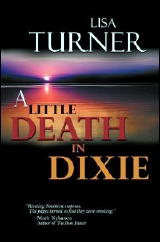
Knifings happen on Friday night. Shootings on Saturday night. The streetlights come up and the shooting begins. Monday mornings? It’s road rage if I-240 backs up and people get a chance to look each other in the eye.
Count on multiple killings the week of a full moon or any day the temperature breaks a hundred degrees and air conditioners give out and die. That’s when murder happens. The calls come in. The squad responds.
But Saturday morning is different. People shouldn’t kill each other on Saturday morning. They should mow their lawns and pick up groceries. Murder ain’t your proper Saturday morning activity.
Except in Memphis. In Memphis you can commit murder any Saturday morning you like.
Mysteries set in the South invariably indulge in what I call Southern Gothic, a mix of jazz riffs, blues, country western music, Ante Bellum atmosphere, eccentric characters, and police caught between violent rednecks, distrustful minorities, political corruption, the conflict between the Old and New South, and a sprinkling of exotic crime and Elvis impersonators.
When the setting for the novel is Memphis you have to expect all of the above. Detective Sergeant Billy Able has just caught a homicide, an elderly black man, Mr. Tuggle, lying in a bed of marigolds outside his clapboard house, shot by his mentally impaired wife. It’s a humid August day ( “Hot, flat, tornado bait.”), but then it is always summer in Southern mysteries it seems.
Able is a thirty-something Mississippian with “the good looks of the Southern aristocracy gone to seed,” and teamed up with dapper slightly burned out, recently divorced, Lou Nevers, who objects to Billy’s second hand suits, and is behaving erratically.
Buck Overton is a Criminal Court judge with a taste for horses and croquet ( “He believed the only true crime a man could commit was to get caught.”) who requests Billy Able’s and Lou Nevers look into a missing person case involving Sophia Dupree, an old flame of Billy’s.
Overton has ties with the dapper Nevers who is headed for a wall at top speed and might take others with him:
“Please tell me this craziness is about a woman. We can fix that.”
“A woman.” Lou chuckled. “You always want an easy answer. If the ball ain’t down the middle of the plate, you can’t see it coming.”
Meanwhile Billy meets Sophia’s sister Mercy Snow and begins to put together the ties between Buck Overton and Sophia, and why Sophia might decide to disappear, especially when a woman found in the river is mistakenly reported as being her.
Exactly how all this comes together, along with Lou Nevers borderline nervous breakdown, is the bulk of Lisa Turner’s novel, which does a Southern variation on the eccentric Joe Waumbaugh style cop novel.
A Little Death in Dixie has some (I presume) first novel problems, and the plot is a bit transparent — you’ll likely figure out what is going on well ahead of the characters, but the writing isn’t bad, and needs only a little paring of overused TV cop cliches to be first rate.
Billy Able is an attractive protagonist, and I wouldn’t mind seeing more of him and Turner if she continues to be this good and is able to up the ante a little.
She does the Memphis background well, and she has done her research regarding the police and the way they think and act. But what she needs is a bit more depth in the plot and the characters and a little less of the feel of an episode of an above average cop show.
There is promise here, and even as it stands, A Little Death in Dixie is entertaining. With a little work Billy Able might graduate to a character to watch out for.
Mon 30 Aug 2010
Posted by Steve under
Reviews[4] Comments
IT IS PURELY MY OPINION
Reviews by L. J. Roberts
M. R. HALL – The Disappeared. Simon & Schuster, hardcover, December 2009; trade paperback, April 2011. Macmillan, UK, hardcover/softcover, January, 2010.
Genre: Licensed investigator. Leading character: Jenny Cooper; 2nd in series. Setting: England.
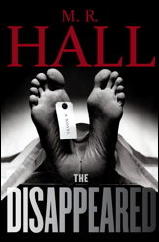
First Sentence: During her six months as coroner for the Severn Vale District, Jenny Cooper had known only a handful of corpses remain unidentified for more than a day or two.
Coroner Jenny Cooper is contacted by the mother of a British Muslim student for a formal inquest on her son. He and his friend both disappeared from their college dorm rooms seven years ago. The authorities claim they went to Afghanistan for terrorist training and failed to do a thorough investigation.
Jenny also has a unidentified Jane Doe in the morgue whose body is stolen but traces of radioactivity left behind. How are the two cases linked and why are the authorities trying so hard to suppress the inquest?
It is very difficult when you really like an author’s first book, yet find their second book so disappointing. What worked well in Hall’s first book, The Coroner (reviewed here ), seemed to come completely undone in this second one.
The protagonist, Jenny Cooper, moved from being a woman finding strength in spite of her issues, to an insipid woman influenced and overwhelmed by everyone; her son, her clerk, her sometimes boyfriend, the police and some rather mysterious lawyer.
Rather than being sympathetic, I found her annoying. At times, her emotional problems notwithstanding, her behavior was so unconscionable it wasn’t even excusable by being fictional. None of the characters were fully developed. Worse yet, I found I didn’t care about or feel connected to any of them.
The only exception was the boy’s mother, Mrs. Jamal, and she was poorly used by the story. There was a sense of place but not strong enough to give me a visual sense of where the story occurred. The author does have a good ear for dialogue but that’s rather damning with faint praise.
The plot seemed to plod on with little sense of tension or suspense. Even the courtroom scenes, so effectively done in her first book, lacked punch or luster. The whole thing felt as though it was a collection news-story ideas (Muslims, terrorists, conspiracies) looking for a cohesive book plot.
The deal-breaker for me was the particularly annoying “you’ll have to read-the-next-book” ending. More than one author has lost me for doing that and Mr. Hall may well be the newest on that list.
The book just doesn’t ever quite work. I did read it all the way through and I don’t mean to say it was absolutely awful; but it wasn’t good either. I shall have to give serious thought as to whether I continue reading this series.
Rating: Poor.
Sun 29 Aug 2010
REVIEWED BY WALTER ALBERT:
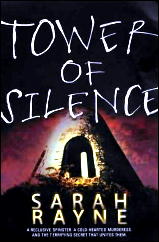
SARAH RAYNE – Tower of Silence. Simon & Schuster, UK, softcover, August 2003; reprint edition: Pocket, UK, July 2009.
Something of a modern Gothic thriller, with long-buried secrets that are teasingly hinted at throughout the novel.
Selina March has lived by herself in a “remote Scottish hamlet” since the death of her uncle and two aunts, but when she accepts a paying boarder, crime novelist Joanna Saville, her secluded life will be significantly altered.
Saville has come to interview inmates of Moy, an asylum for the criminally insane. Moy’s most notorious resident is Mary Maskelyne, who, as an adolescent, murdered three people.
Mary is cunning and resourceful, and when she, predictably, escapes, she sets in motion events that will precipitate buried secrets into the light where long-ago events will finally be brought to a climax and resolved.
Bibliography [Novels] —
Tower of Silence (2003)
A Dark Dividing (2004)
Roots of Evil (2005)
Spider Light (2007)
The Death Chamber (2007)
Ghost Song (2009)
House of the Lost (2010)
What Lies Beneath (2011)
Sun 29 Aug 2010
Posted by Steve under
Reviews[4] Comments
ANNELISE RYAN – Working Stiff. Kensington, paperback reprint, August 2010. Hardcover edition: September 2009.
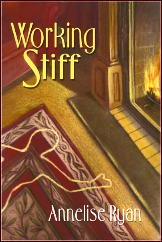
The first few lines may set you back on your heels a little:
I’m surprised by how much the inside of a dead body smells like the inside of a live one. I expected something a little more tainted, like the difference between freshly ground hamburger and that gray, one-day-away-from-the-Dumpster stuff you get in the discount section at the grocery store.
No, this isn’t the next take-off on Patricia Cornwell’s line of books, it really is a cozy, as I thought when I opened it to start reading. Telling the story in the first of a new series is Mattie Winston, former nurse and now the new deputy coroner for Sorenson, a smallish town somewhere in Wisconsin. (Not on any map I’ve found.)
It turns out that Mattie quit her former job when she found her husband, a doctor at the same hospital, having an affair with another nurse. Make that soon to be ex-husband.
But when that other nurse is found murdered, and the unfaithful Dr. Winston is a chief suspect, it is up to Mattie to put on her sleuthing shoes and see if she can’t clear his name. Complicating matters is that Steve Hurley, the hunky policeman in charge of the case is exactly that, hunky.
How long does it take before you, the reader, that this a cozy, not a Cornwell look-alike? Not long at all. Soon after that first paragraph above — which tells you something in and of itself — we learn that the coroner’s name is Izzy and he’s five foot tall, while Mattie is something like six (five foot twelve, she says).
And at the crime scene Mattie loses her panties and kicks them under a chair, she having been called on the case in the middle of night and having neglected to dress as carefully as she might have during the day.
My opinion, as always is that more than 320 pages is also more than enough to conduct a murder investigation, even one with as many tangents as this (such as getting a fashion makeover from the beautician at a local funeral parlor).
You’d like to think, though, that there would also be time enough to add a few clues to the puzzle, but no, while entertaining enough in other ways (we are as eager as Hurley is to learn about Mattie’s famous nipple incident, which happened not so long ago in her past), the investigation goes here and there and finally ends about the same time as the book does.
Coming next, book two in the series: Scared Stiff (September 2010).
Sun 29 Aug 2010
REVIEWED BY DAN STUMPF:
HARRY WHITTINGTON – Desert Stake-Out. Gold Medal s1123, paperback original; 1st printing, June 1961. Reprinted at least once by Gold Medal; plus: Avon, paperback, 1989.
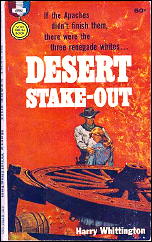
Speaking of wasting a few hours enjoyably, Harry Whittington was a cut above the average paperback hack, and Desert Stake-Out is a cut above the average Whittington.
The story of a lone rider bent on vengeance thrown into uneasy alliance with three outlaws and a callow married couple reads like one of those marvelous Boetticher/Scott westerns of the period, and in fact, Stake-Out is dedicated to Harry Joe Brown, the producer of that series.
Whittington doesn’t break any new ground, but he plows the old fields affectionately enough to yield a crop. Hero Blade Merrick (I guess some folks don’t care what they name their kids) is appropriately terse and hard-bitten, the outlaws are well-realized characters who engage our sympathy even while terrorizing the good folks, and if the sexy heroine and her weakling husband seem a bit pat, they at least serve their function.
Whittington (at his best) had a way with tight writing and fast action, and he serves this up entertainingly.
Sun 29 Aug 2010
Posted by Steve under
Reviews[4] Comments
A REVIEW BY RAY O’LEARY:
MARTHA GRIMES – The Black Cat. Viking, hardcover, April 2010. Reprint paperback: Signet, February 2011.
Superintendent Richard Jury is called in by the Thames Valley Police when a woman is found shot to death in the outdoor seating area of a pub called The Black Cat in Chesham.
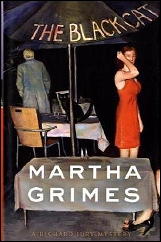
The woman is identified as Mariah Cox, a local librarian, but she was found wearing designer clothes and very expensive shoes and with her hair dyed as if she was attending a party given by the local hoi polloi being held that night.
It’s soon discovered she was leading a double life: during the week a librarian engaged to the local florist, on the weekends, usually spent in London, a highly paid professional escort using the name Stacy Storm. Which woman was the intended victim?
Jury discovers that one of the guests at the party was Harry Johnson, a man Jury knows but cannot prove is a murderer. Jury knows that Harry is the sort of man who might commit murder just to get under Jury’s skin. Did he commit this one?
Meanwhile, the little girl whose aunt is working at The Black Cat claims that her black cat has been kidnapped and replaced by another black cat and wants Jury to find it.
Then another escort, Kate Banks, is shot to death in London. Though two different guns were used, Jury is convinced the killings are connected. Then a third escort is murdered.
It’s a satisfying and well done mystery for the fans of Grimes’ Jury series except for a couple of drawbacks. Steve Lewis said in his review of The Case Is Altered that if you don’t start by reading Grimes’ Jury series from the beginning you won’t know the background of some of the recurring characters who, again, make an appearance in this novel.
The other drawback is that several chapters are devoted to a dog and cat communicating with each other, so be warned if that sort of thing irritates you.
Next Page »











